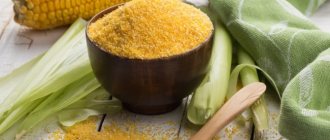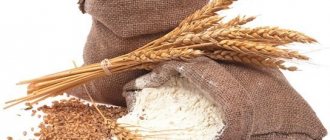Amaranth flour is a food product made from the seeds or cake of the plant of the same name after oil production. Color - light, milky, with a caramel tint; texture - free-flowing, size of individual grains - 60-300 microns. Smell: sweetish; the taste is nutty, pleasant, in its raw form it resembles American granola (a mixture of flattened grains of various cereals with nut crumbs, baked with honey). The starting materials are collected from a plant that, in addition to the main botanical term, is called axamite, acorn grass, cockscomb, velvet, and cat's tail.
How is amaranth flour made?
Converted reapers and combines are used for harvesting. Wait until the stems dry out and turn whitish in color, and then cut off the heads at a height of 30 cm above ground level. Dried and threshed in devices resembling a centrifuge. To remove leaves and household dust, blow or wash, followed by drying. The production of amaranth flour largely depends on the equipment of the farm.
For grinding, a special mill with a built-in grain cleaning and grinding unit is used. The device is an automatic machine consisting of several bins into which grain is poured, and then intermediate raw materials are automatically transferred from one process to another. Productivity ranges from 500 to 1500 kg/hour, including preliminary processes.
Tasty and healthy dishes with amaranth flour are made from low-fat raw materials. First, the seeds are pressed into oil using cold pressing. The original product is not treated with any reagents. The cake is supplied to the mill hopper, from which partially defatted grinding is obtained.
How to make amaranth flour at home:
- The acorn heads with ripening seeds are cut off and laid out for drying in one layer, on racks, in a well-ventilated, dry room. If you do not plan to prepare a large amount of flour, you can dry several “panicles” in a convection oven at 30°C.
- The seeds are peeled between the palms and sifted several times through a sieve with large mesh to separate the grains (they are slightly larger in size than varietal poppy).
- To dry a large batch, use an oven, and a small batch, use a frying pan. By stirring amaranth in a dry, hot frying pan, you can simultaneously get rid of excess fat. To do this, fry briefly once, then wash the dishes, heat them again and repeat the heat treatment.
- For grinding, use a coffee grinder or food processor. To achieve a more uniform structure, the grains are sifted several times and large particles are ground again until the consistency of the powder.
Another recipe for making amaranth flour at home: the dried raw materials are laid out in one layer between paper towels and rolled with force with a rolling pin. The oil is partially separated. Then they are dried in the oven or calcined 1-2 times in a frying pan and only then crushed.
You can buy amaranth flour in large supermarkets. Cost for 200 g - from 165 rubles. in Russia, in Ukraine - from 16 UAH. for the same amount. If they offer it cheaper, you should refuse. Cheap products contain residues of chemicals - unscrupulous manufacturers, in order to reduce the cost of production, purchase the cake left over after extracting oil using the extraction method as a starting raw material. Food use of such a product is unacceptable.
- See also how spelled flour is made
How to take and where to buy
Amaranth grains or flour can be purchased in specialized stores for vegetarians, pharmacies or online stores. When choosing, you need to pay attention to the color and texture of the flour. It is gray-green or milky in color, very fine and light as a speck of dust, compared to wheat flour.
You can use 1 tsp of amaranth flour to prevent seasonal diseases. diluting it with milk, water or honey. The course can last about a month, but before use you need to consult a doctor. Also, as a preventive measure for vitamin deficiency or tumor diseases, you can prepare pasta, bread, pancakes, cookies and other flour products that will help compensate for the lack of nutrients, especially for strict vegetarians.
Composition and calorie content of amaranth flour
Pictured is amaranth flour
Even after partial defatting, the energy value of the product is quite high.
Calorie content of amaranth flour is 344 kcal per 100 g, of which
:
- Proteins - 9.5 g;
- Fats - 3.9 g;
- Carbohydrates - 67.8 g;
- Dietary fiber - 1.1 g.
The permissible moisture content is 11%.
Vitamins per 100 g
:
- Beta Carotene - 0.001 mg;
- Vitamin B1, thiamine - 0.116 mg;
- Vitamin B2, riboflavin - 0.2 mg;
- Vitamin B4, choline - 69.8 mg;
- Vitamin B5, pantothenic acid - 1.457 mg;
- Vitamin B6, pyridoxine - 0.591 mg;
- Vitamin B9, folate - 82 mcg;
- Vitamin C, ascorbic acid - 4.2 mg;
- Vitamin E, alpha tocopherol - 1.19 mg;
- Beta Tocopherol - 0.96 mg;
- Gamma Tocopherol - 0.19 mg;
- Delta Tocopherol - 0.69 mg;
- Vitamin PP - 0.923 mg;
- Betaine - 67.6 mg.
Macroelements per 100 g
:
- Potassium, K - 508 mg;
- Calcium, Ca - 159 mg;
- Magnesium, Mg - 248 mg;
- Sodium, Na - 4 mg;
- Phosphorus, P - 557 mg.
Microelements per 100 g
:
- Iron, Fe - 7.61 mg;
- Manganese, Mn - 3.333 mg;
- Copper, Cu - 525 μg;
- Selenium, Se - 18.7 μg;
- Zinc, Zn - 2.87 mg.
One of the properties of amaranth flour is the renewal of the body and stimulation of collagen production. Not only all forms of vitamin E are responsible for this function, but also a rare substance - squalene. Its direct effect is to slow down the aging process. There is 8 times more squalene in milled agaric than in shark liver!
The predominant digestible carbohydrates in the composition of amaranth flour are starch and dextrins. Small amounts of mono- and disaccharides, sucrose, maltose and fructose.
Amaranth flour contains 10 types of essential amino acids with a predominance of arginine and leucine, as well as 8 non-essential ones - most of all aspartic and glutamic acid, glycine, serine.
Do not be afraid of weight gain - grinding is rarely used separately, and only for health purposes. The addition to the dough changes its properties, makes the knead more airy, fluffy, voluminous, which means the overall calorie content of the dish is reduced.
- See also the composition and calorie content of poppy flour
Benefits of amaranth flour
Weight loss is difficult for people prone to obesity. Introducing grinding acorn seeds into low-calorie diet dishes will help normalize weight. Subcutaneous fat will be burned evenly, appetite will decrease, toxins accumulated in the body will be eliminated naturally. It should be noted that due to the stimulation of collagen production, the skin will not sag. In addition, the incidence of cellulite formation is reduced.
But the benefits of amaranth flour are not limited to fat-burning properties. When regularly added to dishes, the product
:
- Activates metabolic processes at the cellular level.
- Dissolves cholesterol deposited on the walls of blood vessels.
- Stabilizes blood pressure, suppresses excitement.
- It has an antioxidant effect, suppresses the production of atypical cells in the abdominal and intestinal organs.
- Normalizes blood sugar levels, which allows limited use of amaranth flour for diabetes.
- Suppresses the activity of pathogenic fungi and bacteria that have entered the intestines from the outside or through the bloodstream.
- Prevents the formation of keloids, accelerates the healing of postoperative scars and wounds.
- Has a rejuvenating effect.
- Prevents constipation, relieves colitis, peptic ulcers and gastritis of various forms.
- Reduces the frequency of angina attacks.
- Suppresses the development of varicose veins and its development into thrombophlebitis.
Note!
Amaranth flour can be used if you are gluten intolerant. Adding amaranth flour to baked goods during pregnancy helps cope with increased anxiety, prevents the development of pathologies during the formation of the neural tube and central nervous system in the fetus, helps to get enough sleep and stabilizes hormonal levels. This property can also be used after pregnancy to recover faster. During lactation, the product increases the production and has a beneficial effect on the quality of breast milk, strengthens the baby’s immune system.
Useful properties of amaranth
The benefits of amaranth are high, thanks to its valuable composition, rich in vitamins and active substances. The leaves of the plant contain useful substances that are effective in preventing osteoporosis, eliminating calcium deficiency in the body, regulating metabolic processes and reducing the likelihood of cardiovascular diseases.
The beneficial properties of amaranth affect the activity of removing harmful substances from the body, including radionuclides. Amaranth contains plant proteins that are effective in treating eczema, urticaria and skin hyperemia.
Amaranth oil made from the plant contains many trace elements and beneficial substances, which are an effective preventative against the formation of malignant tumors.
Amaranth received positive reviews for its content of squalene, which saturates the body with oxygen, is an antitumor agent and an immunostimulant. The human body needs squalene to reduce the rate of oxidative processes in cells, which cause aging of the body.
International medical studies have shown that constant consumption of amaranth has a positive effect on the functioning of the liver, promotes regeneration and acts as a hemostatic agent for hemorrhoids and internal bleeding.
Amaranth is widely used in the form of a tincture, which is used as an antispasmodic for colitis, gastritis and constipation.
The beneficial properties of amaranth are manifested in the treatment of infectious diseases, dermatitis, endometriosis and fungal infections.
For allergies and diathesis, a decoction of amaranth roots and seeds helps well, and for burns and scars, the oil from the plant is effective.
Contraindications and harm of amaranth flour
Restrictions on introducing a new product into the diet include exacerbations of chronic diseases (pancreatitis, gastroenterocolitis, peptic ulcers), impaired urinary function of the kidneys. You should analyze your condition if you have high cholesterol and anemia.
The glycemic index of amaranth flour is relatively low - 40 units, but with heat treatment it can increase to 50-60 units. This should be taken into account if there is a history of diabetes mellitus, reducing the content of foods containing easily digestible carbohydrates in the daily menu. Grinding acorn seeds can cause an allergic reaction - this should be taken into account when introducing a new taste.
Eating amaranth flour can cause harm
b:
- If cooked incorrectly. If the seeds are not heat treated, the final product may contain oxalates and nitrates.
- Due to the high content of oxalic acid. Frequent exacerbations of gout, arthritis and arthrosis are contraindications for inclusion in the diet.
Caution should be exercised if amaranth powder is used for weight loss. Raw flour can cause nausea, vomiting and eating disorders.
What are the benefits and harms for humans?
Amaranth flour is an invaluable source of squalene, a substance that delivers oxygen to our cells.
This aerial saturation has a beneficial effect on health and well-being.
The product has the ability to easily penetrate tissues and has gained fame as a potent immunostimulant.
It has an amazing effect on free radicals, reducing their destructive effects and preventing the formation of tumors. Amaranth is indispensable in the fight against skin diseases .
Effective in eliminating fungal diseases and restoring frostbitten and damaged skin areas.
If you value youth and beauty of your skin, you should include it in your diet, and you will be guaranteed a radiant, well-groomed look .
| Body systems | Impact |
| Nervous system | Melatonin, produced in the body, harmonizes its work. Sleep improves, symptoms of depression are alleviated, mood improves, attacks of aggression go away |
| Protective | Strengthens the immune system and mechanisms of resistance to adverse environmental influences. |
| Gastrointestinal tract | Normalizes acidity, removes inflammation of the gastric mucosa. B vitamins prevent stomach and intestinal ulcers Squalene and phytosterols affect fat metabolism, and fiber slows down the rate of sugar absorption in the intestines. Removes toxins from the body, improves digestion. Polyunsaturated fatty acids have a beneficial effect on the functioning of the pancreas |
| Cardiovascular | Thins too thick blood, normalizes heart rate, relieves unpleasant chest pain, strengthens the heart muscle |
The video tells in detail about amaranth, its benefits, dangers, chemical composition and properties:
Recipes for dishes with amaranth flour
Grinding acorn seeds is used for baking baked goods - to improve the plasticity of the batch, enrich the taste and beneficial properties. Flour is used to prepare breading, thicken cream soups, sauces and desserts. When consuming the product in its pure form, it is recommended to bake it in the oven at 110°C for at least 7-10 minutes.
Recipes with amaranth flour:
- Popcorn
. Lubricate the heated frying pan with coconut oil, and then spread the ground agarica over it with a spoon (it is better to use something you made yourself, not very fine), stirring constantly. The grains will first begin to stick together and then burst. The dried particles are transferred from the frying pan to a deep bowl, allowed to cool and mixed with nut flour and honey. - Pancakes
. Knead the batter using 2 types of flour, wheat and amaranth, 300 g each, as much water as you need, a little salt, 2 tbsp. l. honey, 50 g of steamed raisins, a little baking powder. The batter is poured with a spoon onto a hot frying pan greased with vegetable oil and fried on both sides. - Cutlets
. Mashed potatoes are mixed with fried onions, fresh green pea puree and grated carrots. For thickening, grinding from acorn seeds is used. Cutlets are formed, rolled in flour as if breaded, and fried in a frying pan greased with sunflower oil. - Sauce for meat or fish
. Fry the flour in a frying pan in butter until golden brown, add water - 1 cup per 50 g, boil until you get a creamy consistency. Add salt to taste, you can add spices or garlic, and replace the water with milk. - Vegetarian noodles
. The dough is kneaded from 2 eggs and 2 cups of amaranth flour, pour in water to make it soft and not stick to your hands. Roll out the mixture into a layer, cut into strips, and dry at room temperature. Store in a hermetically sealed container.
You can experiment endlessly with amaranth flour, adding it not only to dishes, but also to drinks:
- Apple cocktail for rejuvenation
. Mix 2 tbsp into one glass of self-prepared juice. l. grind, beat with a blender, sprinkle with cinnamon. Before serving, add ice to the glass. - Smoothie to increase potency
. The blender bowl is filled with 4 large tomatoes after blanching, without skin, 6 acorn leaves, rye kvass, 250 ml, 0.25 tsp. ground black pepper and 1 tbsp. amaranth flour. Beat until smooth. You can strain it before use. - Warming drink
. Amaranth flour, 60 g, 1 cinnamon stick mixed into 1 liter of warm milk. Bring to a boil over low heat, add 2 tsp. vanilla. As soon as it begins to thicken, remove from heat and sweeten - preferably with cane sugar.
See also recipes for dishes with buckwheat flour.
Simple cooking recipes
Baked goods and dishes with amaranth flour cannot be called dietary, since its caloric content is equal to that of other cereals. The only difference is in the glycemic index of the products and the taste of the dishes obtained by adding amaranth. Below are popular recipes for preparing dishes from amaranth flour.
Pancakes
Peculiarities. Suitable for a quick snack. They differ from ordinary pancakes in their light nutty aroma and taste.
Preparation
- Mix half a glass of water, a pinch of soda, an egg, a pinch of salt, green onions, and a spoonful of olive oil.
- Add amaranth flour until a mass is formed, with the consistency of sour cream.
- Bake in olive oil, preheating the pan.
Bread
Peculiarities. An ideal way to introduce amaranth into the diet in order to enrich it with vegetable proteins.
Preparation
- Mix half a glass of water with a teaspoon of sugar and 10 g of yeast.
- Mix in a little wheat flour and leave to ripen in a warm place for half an hour.
- Add a third of a teaspoon of salt, a spoonful of olive oil, three tablespoons of amaranth flour, and knead thoroughly.
- Add wheat flour until a soft dough forms. Mix well.
- Bake in the oven at 190°C until fully cooked.










